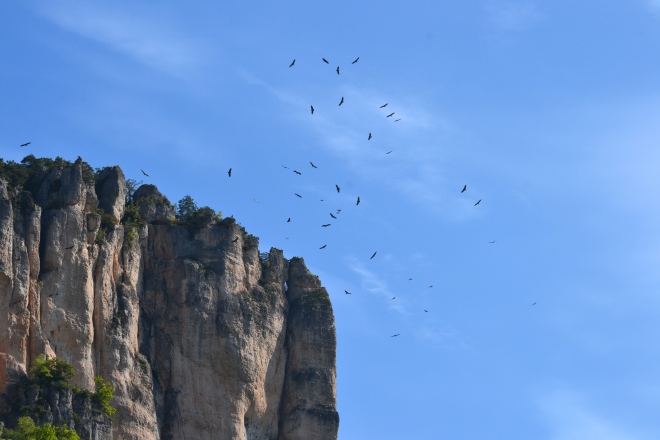After two days largely of frustration I took a break from butterflying to devote some time to that noble and dwindling band of birds, “the stragglers” of my southern Europe wish list. Prominent amongst these and not just by its size was Black Vulture that I had failed to locate on all of my visits to the special protection areas of Portugal’s Baixo Alentejo. But they and other large raptors have been re-introduced to the Causses (limestone plateaux) and gorges of the south-west Cévennes. So this trip presented a good opportunity to nail this straggler.
Birding has not been a priority so far this week. But on early reconnoitres while waiting for the day to warm up I have noted several Red-backed Shrike and a few Cirl Bunting by the roadside. This morning involved a quick 50km drive south on the A75 trunk road that was a nice change from negotiating endless hair pin bends into low sun. My destination was the spectacular Gorges de la Jonte (pictured below), where just west of a village Le Truel there is a vulture observatory Belvedere des Vautours.

Gorges de la Jonte
Griffon Vultures died out in Les Cévennes in the 1940s due to shooting, poisoning of mammals, and compulsory disposal of sheep carcasses. But since 1976 all birds of prey have been protected by law in France, and vulture re-introduction with feeding on private land began in the 1980s. A Griffon colony at Gorges de la Jonte has grown to 443 nesting pairs in 2015. Black or Cinerous Vulture were re-introduced to Les Causses between 1992 and 2004 and now number some 80 individuals and 20 breeding pairs. Since 2012 Lammergeier or Bearded Vulture have completed the scheme, and two breeding pairs of migratory Egyptian Vulture also return to the area each year. So this is potentially the only place in France in which all four species may be seen.

When I drew into the observatory car park, this (pictured above) was the welcoming party. I set up my scope quickly to find almost all the soaring and cliff-top birds were Griffons, but then a darker individual flew in and perched prominently on one crag. I began to pick off the diagnostics then this bird turned its head to reveal a purplish blue beak. This was indeed my Black Vulture for the trip, then Griffons landed on either side of it for comparison before harassing the interloper off its perch.
Seeing this lifer upon my arrival showed that its removal from the straggler ranks here was meant, after so much fruitless searching in Portugal. And although Belvedere des Vautours may be termed a Loch Garten or Rutland Water type location, finding a Black Vulture here still has provenance in my view. There is no certainty of seeing the latter since as tree nesters they do not breed on the cliffs with the Griffons. But individuals do stop by so I had been fortunate to have sighted one so well.
Once this excitement was over I went into the observatory where 6.70 euros gains admission to a museum that educates visitors on all things vautour. When a group of people builds up everyone is invited inside for a very informative audio visual presentation with English subtitles. Afterwards I stayed on the observatory roof for some time watching the Griffons on the cliffs overhead (pictured below), but it could have been a long wait for a Lammergeier or Egyptian to drop in. So around midday I decided to drive north into Le Causse Mejean on the off chance of crossing paths with either of these or Golden Eagle that are also in this area.

The cliffs at Belvedere des Vautours
Choosing an ascent at random I became distracted by a broad and butterfly friendly looking track that led up a wooded valley from N44° 13.401′ E3° 17.631′. Eventually this took a hairpin and emerged above the tree line. I had brought a recording here of another straggler Western Bonelli’s Warbler that I familiarised myself with at the start of this walk. Now here was that very call coming from cover at one side of the track. I had several views of the bird but it didn’t stay still for long enough to focus on. So that was both my bird trip targets gained in one morning.
I began to regret not having genned up on Western Orphean as well. On the walk back down I did hear Bonelli’s again in two more locations and it’s a call I will not now forget. I must be getting to grips with this Xeno Canto malarky, having identified three new warblers on call in the last five months. The others were Dusky at Ham Wall, Somerset (see here) and Iberian Chiffchaff at Telford, Shropshire; but since the latter wasn’t seen it hasn’t been blogged either.
The following day I started at Gorges de la Jonte again, finding another large concentration of Griffons a little to the east of Belvedere des Vautours at N44° 92.394′ E3° 97.452′. Here there was also a large colony of cliff-nesting Red-billed Chough, that are widespread in the gorges of Les Cevennes. Having got to know this corvid so well on Portugal’s Sagres peninsula in January it was good to have another satisfying experience of them here.
